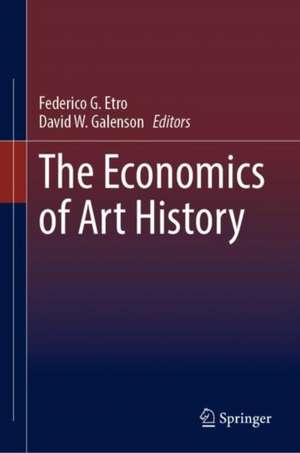The Economics of Art History
Editat de Federico G. Etro, David W. Galensonen Limba Engleză Hardback – 2 iul 2024
Preț: 635.52 lei
Preț vechi: 836.22 lei
-24% Nou
Puncte Express: 953
Preț estimativ în valută:
121.65€ • 132.18$ • 102.25£
121.65€ • 132.18$ • 102.25£
Carte tipărită la comandă
Livrare economică 16-22 aprilie
Preluare comenzi: 021 569.72.76
Specificații
ISBN-13: 9783031576454
ISBN-10: 3031576454
Ilustrații: V, 200 p.
Dimensiuni: 155 x 235 mm
Greutate: 0.45 kg
Ediția:2024
Editura: Springer Nature Switzerland
Colecția Springer
Locul publicării:Cham, Switzerland
ISBN-10: 3031576454
Ilustrații: V, 200 p.
Dimensiuni: 155 x 235 mm
Greutate: 0.45 kg
Ediția:2024
Editura: Springer Nature Switzerland
Colecția Springer
Locul publicării:Cham, Switzerland
Cuprins
The Economics of Art History, F. Etro, D. Galenson.- Valuing European Tapestry: From Riches to Rags” A. S. Radermecker and K. Brosens.- Measuring nepotism and sexism in artistic recognition: the awarding of medals at the Paris Salon, 1850–1880, C. Dupin de Beyssat, D. S. Greenwald, K. Oosterlinck.- How Monet became a millionaire: the importance of the artist’s account books, K. Simon.- The rise and fall and rise again of the contemporary art market, R. Jensen.- Two old masters and a young genius: the creativity of Francis Bacon, Lucian Freud, and Jean-Michel Basquiat, D. Galenson and S. Lenzu.- Residual variance and asset pricing in the art market, J. Mei, M. Moses, Y. Zhou.- Risky business? A review of Jonathan Nelson & Richard Zeckhauser’s Risk in Renaissance Art: Production, Purchase and Reception, E. Piano.
Notă biografică
Federico Etro is Professor of Economics at the University of Florence. He previously taught at the Ca’ Foscari University of Venice, the University of Milan, the Luiss University of Rome and the University of Edinburgh. Etro has published numerous articles in economic journals such as the American Economic Review, American Economic Journal, European Economic Review, International Economic Review, Economic Journal and articles on art markets and the economics of art history on journals such as the Journal of Economic History, Journal of Cultural Economics, Journal of Economic Behavior and Organization and many others. He has written books for Springer on “Competition, Innovation, and Antitrust” (2007) and “Endogenous Market Structures and the Macroeconomy” (2009). He has been editor of Research in Economics and is currently editor of the Journal of Cultural Economics. His theoretical and empirical research on the economics of arts is focused on understanding economic and institutional factors that have affected the evolution of art history across time and space
David Walter Galenson (born June 20, 1951) is a professor in the Department of Economics and the College at the University of Chicago, and a research associate of the National Bureau of Economic Research. He has been a visiting professor at the California Institute of Technology, Massachusetts Institute of Technology, the University of Texas at Austin, the École des Hautes Études en Sciences Sociales in Paris, and the American University of Paris. He is the Academic Director of the Center for Creativity Economics, which was inaugurated in 2010 at the Universidad del CEMA, Buenos Aires. He is the son of economists Marjorie and Walter Galenson. He attended Phillips Academy.He then studied at Harvard College for both his undergraduate and graduate education, completing his PhD in 1979.
David Walter Galenson (born June 20, 1951) is a professor in the Department of Economics and the College at the University of Chicago, and a research associate of the National Bureau of Economic Research. He has been a visiting professor at the California Institute of Technology, Massachusetts Institute of Technology, the University of Texas at Austin, the École des Hautes Études en Sciences Sociales in Paris, and the American University of Paris. He is the Academic Director of the Center for Creativity Economics, which was inaugurated in 2010 at the Universidad del CEMA, Buenos Aires. He is the son of economists Marjorie and Walter Galenson. He attended Phillips Academy.He then studied at Harvard College for both his undergraduate and graduate education, completing his PhD in 1979.
Textul de pe ultima copertă
This book expands our understanding of art markets and their impact on art creation through interdisciplinary contributions by economists and art historians. The study of art history has been traditionally focused on the description of artistic innovations, the role of the artists that made them and the meaning of the artworks they created. It has often neglected the broader reasons why certain innovations took place in certain places, in specific times and in particular ways. Exploring old, modern and contemporary art markets, the book shows that the impact of institutional and economic factors has been critical in shaping the evolution of art history, and quantitative methods can be useful to improve our understanding of the history of figurative arts and the relationship between market structure and creativity. It is of great interest to cultural economists, art historians and students and scholars interested in understanding art markets.
Caracteristici
Studies the economic determinants of art history with a quantitative approach Brings together an interdisciplinary group of scholars within art history and economics Deals with old master paintings, impressionism and contemporary art through the lens of economics
